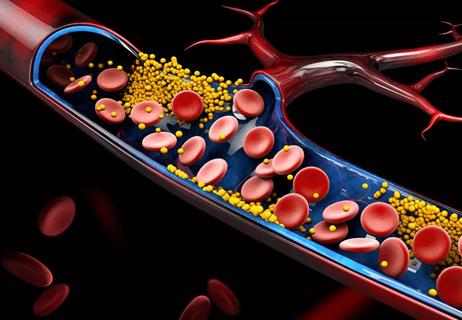Tech-assisted self-selection concurred with clinician-assessed eligibility in >90% of cases

For the first time, a web application has been shown to enable consumers to accurately self-select for nonprescription statin use, correctly administer statin therapy and achieve clinically important reductions in LDL cholesterol (LDL-C). These findings — from a study presented as a late-breaking clinical trial at the American College of Cardiology Annual Scientific Session 2024 and published online in the Journal of the American College of Cardiology — suggest that this technology-assisted approach has the potential to safely expand access to statin therapy to more patients who need it.
Advertisement
Cleveland Clinic is a non-profit academic medical center. Advertising on our site helps support our mission. We do not endorse non-Cleveland Clinic products or services. Policy
In the study, the technology-assisted approach qualified individuals for statin treatment at levels that closely matched clinician assessments of the individuals’ eligibility for statin therapy for cholesterol reduction. When study participants were given access to a 5-mg dose of rosuvastatin using this approach, they obtained a mean 35.5% reduction in LDL-C six months after starting treatment.
“Fewer than half of patients eligible for statins for primary prevention under current guidelines receive them,” says study presenter and lead author Steven Nissen, MD, Chief Academic Officer in Cleveland Clinic’s Heart, Vascular, and Thoracic Institute. “We believe this therapeutic approach can make statins available to more people not currently taking them. It’s designed to allow nonprescription access to consumers who should be treated while preventing access for those in whom statins are not indicated or potentially unsafe.”
The investigation, known as the Technology Assisted Self-Selection in Consumers (TACTiC) study, builds on an earlier study by the same researchers (J Am Coll Cardiol. 2021;78[11]:1114-1123) demonstrating that participant self-selection for statin therapy using this technology-assisted approach showed substantial agreement with clinician selection and successfully screened out a high percentage of participants ineligible for statin use.
The new TACTiC investigation was designed as an actual use study that focused on participants likely to be appropriate for statin therapy and that also assessed adherence to therapy and impact on LDL-C in addition to concordance between consumer and clinician assessment of statin eligibility.
Advertisement
The study involved use of the Technology-Assisted Self-Selection (TASS) tool embedded within an English-language web application. The TASS program prompts users to enter demographic and medical information along with laboratory values (including cholesterol and other lipid measures) and blood pressure data to determine eligibility for moderate-intensity statin therapy (i.e., rosuvastatin 5 mg/day) without a doctor visit or prescription.
The app bases its determination on the 2018 American College of Cardiology/American Heart Association cholesterol treatment guidelines and includes key portions of a proposed drug facts label for nonprescription rosuvastatin. Based on their responses to the TASS prompts, users are informed whether they are eligible for statin use (“OK to use”), are not eligible (“Do not use”) or should ask a doctor for further advice (“Ask a doctor”).
The study sample was drawn from individuals aged 20 to 75 years who responded to advertisements for a study about heart health and had no history of employment in healthcare. After initial screening, respondents were invited via email to complete the web app assessment. Of 12,624 respondents who completed the assessment, 10,332 received a “Do not use” outcome.
The remaining respondents (who received “OK to use” or “Ask a doctor” outcomes) were directed by the web app to schedule a virtual visit with a clinician via the study’s call center. At the virtual visit, participants were interviewed by a clinician blinded to the information participants had entered in the web app. The clinician then used verified lab and blood pressure data to make an independent assessment of statin eligibility; participants were blinded to the results of their clinician assessment.
Advertisement
All participants who qualified for therapy based on their initial assessment were eligible to continue to the study’s six-month treatment phase. This involved setting up an account in the web app and purchasing up to a 90-day supply of rosuvastatin 5 mg/day, which was paid for by participants and shipped to their homes.
During the treatment phase, participants were required to take an abbreviated web app assessment before reordering medication to ensure they continued to meet requirements for safe use. Participants were also instructed to have their LDL-C remeasured. After six months of treatment, participants completed another web app assessment and were scheduled for a final virtual visit and again interviewed by a clinician.
The Cleveland Clinic Coordinating Center for Clinical Research (C5Research) served as the academic coordinating center and independently reviewed participant outcomes to determine suitability for statin treatment.
In total, 1,196 participants gave informed consent and were included in the study. Median participant age was 63 years, with 93% of participants aged 50 or older. The population was predominantly male (60%) and mostly white (79%) or Black (12%). All but 4% had literacy above an 8th-gradelevel.
The population’s mean baseline LDL-C was 139.6 mg/dL and median clinician-calculated 10-year risk of atherosclerotic cardiovascular disease was 10.1%.
Results on the study’s primary outcome measures were as follows:
Advertisement
Additionally, compliance with LDL-C remeasurement was documented in 83.8% of all participants and in 92.9% of the 910 participants who qualified for therapy at all reassessments. Among these 910 participants, 98.5% purchased enough pills to last for the full treatment period. Dosing adherence based on pill counts of returned bottles was 95.1%.
No participants experienced serious adverse events related to rosuvastatin.
“Not only did participants self-select correctly, they also demonstrated they could appropriately self-administer the drug and they obtained LDL cholesterol reductions that were about what you’d expect with high adherence,” Dr. Nissen observes.
He notes that several earlier efforts to achieve regulatory clearance for nonprescription statin therapy have failed, largely due to concerns about consumers’ ability to accurately self-select for therapy. “Those efforts relied too much on reading drug labels, which consumers don’t tend to do well,” Dr. Nissen explains. “This web-based approach overcomes those challenges by guiding consumers through the self-selection process and then delivering the statin to them directly rather than through over-the-counter availability. It was designed to prevent overuse by the worried-well and inappropriate use by people in whom statins could potentially cause harm.”
“Patients are increasingly looking for tools to help assess their own health and improve their future health,” adds study co-author Luke Laffin, MD, staff physician in Cleveland Clinic’s Section of Preventive Cardiology. “One need look no further than the explosion of books from ‘longevity experts’ to see this phenomenon. From a cardiovascular perspective, statins are very safe and decrease future risk of cardiovascular disease. Using technology to empower patients to self-select for statin therapy is the future, and this study shows it can be done safely and effectively.”
Advertisement
Dr. Nissen expects the TASS tool and web-based app to undergo FDA review soon, potentially clearing a path for nonprescription availability of statin therapy for the first time in the United States.
The study was funded by AstraZeneca, which markets the Crestor® brand of rosuvastatin, which is also available in generic versions.
Advertisement

Phase 3 TANDEM study may help pave way to first approval of a CETP inhibitor

Reassurance from the lipid outcomes trial with the highest percentage female enrollment to date

Robust reductions in cardiac events seen in high-risk patients without prior events

Findings bolster the oral drug as an option for primary and secondary prevention

Effect on gut microbiome emerges as another benefit of statin therapy

Randomized controlled study undercuts unsubstantiated ‘heart health’ claims

First-in-human phase 1 trial induced loss of function in gene that codes for ANGPTL3

Yet 21.4% of tested individuals had Lp(a) elevation